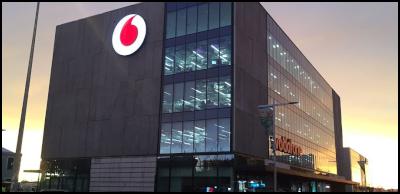Vodafone’s new Christchurch home achieves Green Star rating
MEDIA RELEASE
For immediate release / Wednesday 27 July, 2016
Vodafone’s new Christchurch home achieves
‘New Zealand excellence’ Green Star
rating

The InnoV8 building has become the first in Christchurch’s growing Innovation Precinct to achieve a Green Star rating – meaning Vodafone will benefit from its sustainable, energy-efficient design.
InnoV8 is a 8500 square-metre building, comprising four levels of office space, and a Vodafone Concept Store and cafés on the ground floor. It has achieved a 5 Green Star Design rating, denoting New Zealand excellence, and was officially opened this morning.
The building boasts, among other features, passive solar design and a high-performance façade to maximise daylight while balancing heat levels; an integrated fit-out design to reduce waste; and a highly efficient ventilation system that brings in outdoor air at a rate 50% above what’s required by Building Code, to provide a healthier indoor environment for staff.
Green Star is an independent rating system that assesses buildings’ sustainability across a range of criteria, at both Design and Built stage, and is certified by the New Zealand Green Building Council (NZGBC). Ratings range from 4 Green Star (best practice) to 6 Green Star (world leadership).
Designed by Jasmax and located at 213-221 Tuam St, the InnoV8 building is being developed by Studio D4 and Calder Stewart Development with the end investor being Tuam Street West Ltd. InnoV8 will be leased under an exclusive long-term agreement with Vodafone.
NZGBC chief executive Alex Cutler says that as the rebuild continues, it’s inspiring to see companies creating high-performing buildings that have a smaller environmental footprint – and using an independent rating tool to certify that the green features measure up internationally.
“Designing for sustainability is the best way to ensure lower energy bills, a healthier indoor environment and a more resilient building. This makes a Green Star building a smart long-term investment, as those features mean it’ll be more attractive to both investors and tenants,” says Ms Cutler.
“Together, Tuam Street West and Vodafone have created a building that is fit for the future, and will also be an attractive, comfortable space for staff and visitors. It’s an example that we hope other companies will follow when building in Christchurch.”
Vodafone New Zealand chief executive Russell Stanners says InnoV8, their new South Island base, is home to 350 Vodafone staff, as well as participants in the Vodafone xone ‘innovation incubator’.
“Sustainability is a non-negotiable part of the future of working. Because technology is at the centre of our business, we wanted to move into a building that helps us run that technology as efficiently as possible. InnoV8 also enhances staff wellbeing and productivity through clever design and material choice. This building illustrates our commitment to Christchurch, and to ways of working that promote sustainability and wellbeing as well as business success.”
Development partner Paul Naylor, co-director of Studio D4, says InnoV8’s Green Star rating is independent proof that the new building’s sustainability features will perform well over time.
“Our decision to work towards a Green Star rating for the InnoV8 building was an easy one: a building that enhances staff wellbeing and productivity, and costs less to run and maintain, will always be a better asset to own. We worked closely with Vodafone to create a home that suits their technology-driven working style while minimising the environmental impact, and we’re delighted with the results.”
Other sustainability features of the office include:
• LED lighting and presence detectors throughout the office area, to reduce energy consumption;
• water metering and alarmed leak
detection to ensure water consumption is effectively
managed, and low-flow water fittings;
• building
tuning for 12 months following completion to ensure building
systems perform to their design
potential;
• diverting 90% of site waste from
landfill through reuse and recycling;
• dedicated
fuel-efficient and carpool car parking, and cyclist
facilities;
• FSC-certified
timber;
• low-VOC materials are specified throughout
to reduce the impact on occupant health from products
(flooring, ceiling tiles, adhesives and sealants) that emit
pollutants; and
• storage systems for recycling
waste.
The Green Star Accredited Professionals were
Peter Bryant and Torin Hay, co-directors of SEEC.
ENDS


 New Zealand Association of Scientists: NZAS Supports Saving Biotechnology Capacity In Callaghan; Asks What Now For Applied Technology Group
New Zealand Association of Scientists: NZAS Supports Saving Biotechnology Capacity In Callaghan; Asks What Now For Applied Technology Group Stats NZ: Business Employment Data - December 2024 Quarter
Stats NZ: Business Employment Data - December 2024 Quarter Transpower: System Operator Launches Review Of Electricity Risk Forecasting Framework
Transpower: System Operator Launches Review Of Electricity Risk Forecasting Framework  The Conversation: NZ’s Glaciers Have Already Lost Nearly A Third Of Their Ice – As More Vanishes, Landscapes And Lives Change
The Conversation: NZ’s Glaciers Have Already Lost Nearly A Third Of Their Ice – As More Vanishes, Landscapes And Lives Change RBNZ: Reserve Bank Of New Zealand Welcomes The Release Of Te Ōhanga Māori 2023 Report
RBNZ: Reserve Bank Of New Zealand Welcomes The Release Of Te Ōhanga Māori 2023 Report Bill Bennett: Download Weekly - One NZ chooses Ericsson for core network update
Bill Bennett: Download Weekly - One NZ chooses Ericsson for core network update



